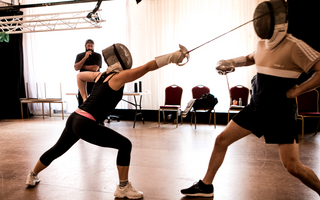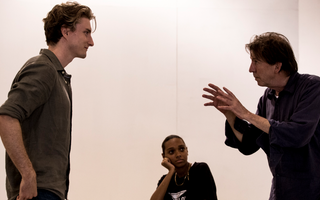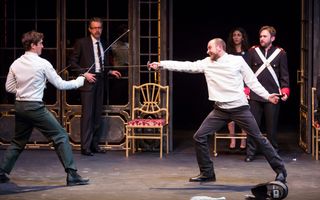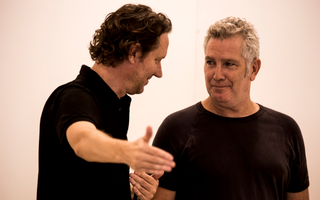 On Stage
On Stage
Hamlet, unlike any other text of its kind, has stood the test of time because of its remarkably modern exploration of the deep concerns of humanity.
Despite this, the play is very much an object of its time and reflects a period of great change and uncertainty. Hamlet was written and performed in the final years of Queen Elizabeth I’s reign. Just as the play ends with the death of the Hamlet line, Elizabeth was the last of the Tudors and she was dying without an heir. Elizabeth’s upcoming death could throw the country into political upheaval, as it was feared that with her death, the religious war between Catholicism and Protestantism would be reignited.
The ideal of the Renaissance Prince would have been familiar to Shakespeare’s audience. They would expect him to be both a poet and a soldier, to be cultivated in manners, capable in rhetoric, and skilled in fencing. It is this ideal that Ophelia refers to when she speaks of “The courtier’s, soldier’s, scholar’s, eye, tongue, sword” (Act 3, Scene 1) that Hamlet possessed.
Dating
Hamlet has had a long publishing and performance history which complicates the dating of the play. The origins of the story lie in the historic records of Saxony. The 12th-century Saxon historian Saxo Grammaticus first wrote down the history of Prince Amleth avenging his murdered father by killing his usurping uncle. The story would have been known to Elizabethans in French, via François de Belleforest’s Histoires Tragiques, published in 1570. In the source material the young Amleth pretends to be mad so his uncle will not see him as a threat. He is biding his time and growing to manhood, in order to take revenge.
Shakespeare was very fond of re-working existing material into new form, and Hamlet is a good example of this. It is known that there was a play called Hamlet that was popular in the 1580s and 90s, 10 years or more before Shakespeare wrote his version. We no longer have a copy of this play, which is often referred to as the Ur-Hamlet (meaning early or primitive). Despite this, Hamlet (as we know it today) was probably written during 1599-1600 and then first performed in the following year. It is not known for certain whether it was Shakespeare’s company, the Chamberlain’s Men, or the other major company at the time, the Admiral’s Men, who performed the earlier version, but it seems most likely that Shakespeare re-wrote another company’s story to give his own troupe the opportunity to cash in on a rival’s success and show how they could do it better.
Shakespeare’s son, who died at the age of 11, some years before Hamlet was written, was named Hamnet, after his godfather, Hamnet Sadler.
The text
The Hamlet that we have today is a mixture of the various versions of the text that have come down to us through history. The play was first printed in quarto in 1603, however, this version is known as the ‘Bad Quarto’ as it only contains half the text. Famously, instead of asking, To be or not to be, that is the question, the Hamlet of the bad quarto says, To be, or not to be, aye there’s the point. A quarto was a small, cheaply and quickly assembled book.
The Bad Quarto seems to have been the work of an actor remembering as much as he could. He was probably playing Marcellus because those are the lines he got right! In 1604 the Second Quarto was printed, the longest version of the play and what most modern editions are based on. Finally, Hamlet was again published in the Folio of 1623 in the collected edition of Shakespeare’s works. This version shows significant differences that have prompted many fascinating considerations of how a play text will change over the course of its life in a company’s repertoire.
INTELLECTUAL BACKGROUND
Theatrical
Hamlet was probably first performed in 1600 or 1601, when Shakespeare’s company had only recently transferred to the Globe Theatre.
While Shakespeare was writing Hamlet, the new Globe Theatre was being built to house the Lord Chamberlain’s Men, the theatre company Shakespeare wrote for. The theatre itself becomes a presence within the play, with constant meta-theatrical references to acting, costumes, a play-within-a-play, and watching theatre. Much of Hamlet is a meditation on life being like a play in which we all perform a role. Hamlet, however, does not want to play his given role of the avenger.
Generically, Hamlet is a revenge tragedy. Revenge tragedy was an enormously popular genre in the Elizabethan and Jacobean periods. Its basic structure required a murder that happened before the play commences, which the protagonist, the victim’s father, son, or lover is compelled to avenge. This type of plot was used by playwrights to explore the themes of political absolutism and corruption. Shakespeare, however, developed the genre further. He used violence as a way to create moral ambiguity and to question the results of violent action.
Theological
Shakespeare wrote Hamlet at the end of a century ridden with religious upheaval. In the 70 years before the staging of the play, England went from Catholic to Protestant to Catholic and finally back to Protestantism again with Queen Elizabeth I. Protestantism had finally been cemented by the reign of Elizabeth however, Catholicism was still part of the English psyche (Shakespeare’s father was himself a Catholic). This religious debate was at the heart of England’s political development during the sixteenth century, and Shakespeare draws upon this for his play.
It is significant that Hamlet hails from Wittenberg, the city where Luther nailed his 95 theses to the door of the Church, a catalyst for Protestantism sweeping through Europe. When the Ghost appears to Hamlet, he says that he has come from purgatory, which is a Catholic belief. Hamlet initially distrusts the Ghost as to believe him would mean to accept the truth of the Catholic doctrine. Despite Hamlet’s trust in the Ghost, he still questions religion at every turn. As a character, Hamlet is ultimately unable to find any consolation in religion. Despite this, Hamlet looks back with some nostalgia towards Catholicism and with some hope that the two religions could exist side by side in the same world.
Philosophical
Although the philosophical questions posed in Hamlet are ones eternally faced by humanity, the process of answering them are a reflection of Shakespeare’s time. The characterisation of Hamlet as a university student allows the play to explore the humanist philosophy of the period, which Hamlet would be studying. Humanism in the Renaissance aimed to understand the full capabilities of humanity and lead to the betterment of society. Humanists believed in the importance of education and the concept of the individual having agency over their own life and actions. However, by the end of the Renaissance, humanist thinking became more sceptical, arguing that human knowledge was flawed and limited. This scepticism is reflected in the play as Hamlet is unable to see humanity as good, but evil. Furthermore, sceptical humanism argued that truth is not easily found nor understood. In the play, Hamlet’s understanding of the world is shown to be opaque, despite his skills of rhetoric and reasoning.
The Essais of the French philosopher Michel de Montaigne are a likely influence on Hamlet’s speeches about mortality, conscience, and the purposes of existence. This book was gaining influence amongst the educated classes during this period, when philosophy was replacing theology as the major intellectual pursuit.











